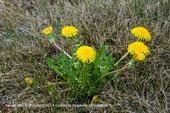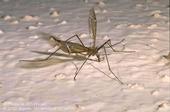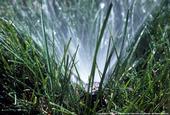
Dandelions are broadleaf plants easily recognizable by their bright yellow flower and puffball of white tufted seeds heads. While this plant is appreciated as a food or herb by many, for equal numbers of others it is regarded as a weed when found growing in lawns, ornamental plantings, and athletic fields throughout the year.
For helpful nonchemical and chemical management solutions to help you control this weed, read the newly revised Pest Notes: Dandelion by UC Cooperative Extension Advisor John Roncoroni.
- Author: Michelle Le Strange
- Author: Carol A Frate
- Author: R. Michael Davis
![Newly emerged inky cap mushrooms, Coprinus comatus. [R.M.Davis]](https://ucanr.edu/blogs/UCIPMurbanpests/blogfiles/41367small.jpg)
Wet weather is favorable to mushrooms, which are sometimes called toadstools. Mushrooms are the visible reproductive (fruiting) structures of some types of fungi. Although the umbrella-shaped fruiting body is the most common and well known, mushrooms display a great variety of shapes, sizes, and colors. Some other fruiting bodies encountered in lawns include puffballs, stinkhorns, and bird's nests, descriptive names that reveal the diversity of forms among mushrooms. But regardless of shape, the purpose of all fruiting bodies is to house and then disseminate spores, the reproductive units of fungi.
Many people become concerned when mushrooms appear in their lawns; however, most mushroom-producing fungi in lawns are merely...
- Author: Karey Windbiel-Rojas
- Contributor: Andrew Mason Sutherland

You may be seeing long-legged, flying insects in your house lately, bouncing around the walls, ceilings, and corners. Many people call these “mosquito hawks” or “mosquito eaters,” but unfortunately, they are not predators of mosquitoes.
These flying insects are actually adult crane flies and although annoying to find in the home, they are basically harmless and won't help with any mosquito problems.
Many reports claim these adult European crane flies (Tipula paludosa) bite or sting, but this is false. Most adult crane flies, which superficially resemble large mosquitoes with very long legs, eat very little, if at all. Adult crane flies live for only a few weeks, and when they find their...
- Author: Dennis Pittenger

[From the August 2015 issue of the UC IPM Green Bulletin]
Q. How much water do landscapes use in California?
A. Landscape irrigation accounts for only about 9% of total statewide developed water use, but the percentage varies widely among communities. Water applied to landscapes is estimated to account for about 50% of residential water consumption statewide, but the amount varies from about 30% in some coastal communities to 60% or more in many inland suburban communities.
Q. Does a landscape have to...
- Author: Karey Windbiel-Rojas
![A drop fertilizer spreader. [Photo by Steven Lock]](https://ucanr.edu/blogs/UCIPMurbanpests/blogfiles/24837small.jpg)
Fall is just around the corner so it's time to start thinking about fertilizing your lawn. All types of lawns are actively growing during the fall months. Fertilizer applied at this time will help ensure that turfgrass is vigorous enough to outcompete weeds and resist other potential pest problems.
For best growth, most lawns need to be fertilized two to three times a year, at least once in fall and once in spring. Nitrogen is the only nutrient that turfgrass needs on a regular basis. However, it may be beneficial to apply a complete fertilizer containing nitrogen, phosphorus, and potassium at least once a year.
Many retail nurseries and garden centers carry both quick-release and slow-release fertilizers. Although more...


